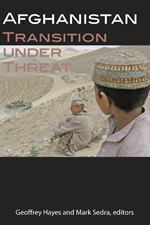|
Reviewed by Paul Kamolnick, Ph.D., Professor of Sociology at East Tennessee State University. In recent years, there have been numerous highly-charged political debates in Canada over whether or not to continue involvement in post-9/11 U.S., NATO, United Nations, and bilateral Canadian missions. In the initial aftermath of al-Qaeda’s 2001 terror attacks against the U.S., there was a consensus in Canada, like in the U.S., on removing the Taliban and militarily hunting down and destroying the 9/11 perpetrators. Their ability to match the American commitment of forces, however, was constrained from the beginning and the stress on their military would only grow as the months and years separated us from the 9/11 attacks. Unlike the United States, Canada’s entire armed forces—all branches inclusive—was in 2005 numbering 62,181 total persons. The Land Forces, commonly referred to as the Canadian Army, numbered a mere 20,458 at the time—the size of just two U.S. Army divisions. Moreover, Canadian politics includes socialist, French separatist, internationalist, and strongly pacifistic elements that complicate governing coalition formation. The national consciousness of Canadians is also torn between its Anglospheric inclinations to join Coalitions of the Willing from World War II to the present; and on the other hand, deep suspicions of being a minor partner in U.S.-led enterprises, or of being associated with perceived militarist adventurism rather than internationally-sanctioned development and post-conflict peace-building centering on the 3D’s of defense, development, and diplomacy. It is within this framework that Geoffrey Hayes and Mark Sedra present Afghanistan: Transition Under Threat, an edited volume that contains eleven chapters organized into four sections which analyze respectively political (chs. 1-3), economic (chs. 4-5), security (chs. 6-8), and uniquely Canadian dimensions (chs. 9-11) of challenges confronting the post-Taliban (c. 2002 – 2006) transition in Afghanistan. Originating in a workshop held in Waterloo, Canada in December 2006, chapters were penned by persons with significant expertise or practical experience in Afghanistan/South Asia drawn from a broad spectrum of relevant institutional contexts—international and Canadian academics, the Canadian International Development Agency (CIDA), the World Bank, ambassadorial posts, former Afghanistan ministerial posts, independent consultants, and a retired colonel in the Canadian Armed Forces who served in Afghanistan from August 2005-August 2006. Though originating in the context of Canadian political debates, the volume’s center of gravity is not Canada in Afghanistan, but Afghanistan itself, objectivity considered, as a genuine national policy dilemma. For that reason, it is of immediate relevance to decision-making processes presently confronting the United States and those nations whose soldiers and national coffers will provide the means for proceeding in this key theater of “The Long War.” Though individual authors vary in their respective assessments—vis-à-vis questions of ultimate culpability, critical thresholds, missed opportunities and key variables—a single verdict effortlessly arises from its composite message: Afghanistan is on the brink of genuine state failure. Further, though ways forward can be imagined, there are absolutely no guarantees; and, the populaces of donor nations are likely to sour and turn on their respective governments unless goals are clarified, definite progress is forthcoming and a credible path forward is persuasively marked. In short, the very question we are now asking–What is the vital national security stake that requires decades, billions, and prioritized commitment to a desperately impoverished Central Asian nation that is becoming by the moment, a more difficult project to justify?—is the question this conference was convened to answer, or better, furnish relevant data and analyses, for such an answer. Though detailed discussion of authors’ contributions are not possible, one is strategically key and worthy of mention. Antonio Giustozzi in his contribution –The Neo-Taliban Insurgency: From Village Islam to International Jihad—offers what is, at present, an unwarranted assertion vis-à-vis what is likely the most important question facing the international community—is the Afghanistan Taliban primarily a nationalist Pashtun Islamist movement strategically independent of global jihadism, or is it now inextricably linked to global jihadism, and therefore regardless of cost, the U.S. and its allies have no choice but to deflate and defeat this globally-linked insurgency in a project of armed state-building? Giustozzi asserts that “[b]y 2006 there were clear signs that the Taliban were becoming an integral part of a wider supra-national jihadist movement, to a much greater extent than the ‘old Taliban’ ever were” (p. 182); speaks of “the Taliban’s new global jihadist ‘soul’ . . . [and] the[ir] belief . . . that victory will come with the overstretching of the enemy through the creation of ‘one, ten, a hundred Iraqs’ rather than with country-specific strategies”; and finally, of “their pan-jihadist aims” (p. 183). It is impossible to overemphasize the seriousness of this charge, and imperative to determine its veracity. Development studies, area studies, South Asian history, international relations, national security studies, post-conflict peace studies, are the principal academic audiences for this text. Many others employed in government, international organizations, NGO’s, and the relevant private sector, are also likely beneficiaries. It is important for academics outside of Canada to learn how Canadians, whose GDP and armed forces are a small fraction of America’s, view the magnitude of the challenges, sacrifices, and dilemmas facing Afghanistan c. 2006. Jargon-free in general, well-edited, with a very satisfactory index, the volume is suitable as a supplemental text for advanced undergraduates and above. |


 Afghanistan: Transition Under Threat
Afghanistan: Transition Under Threat